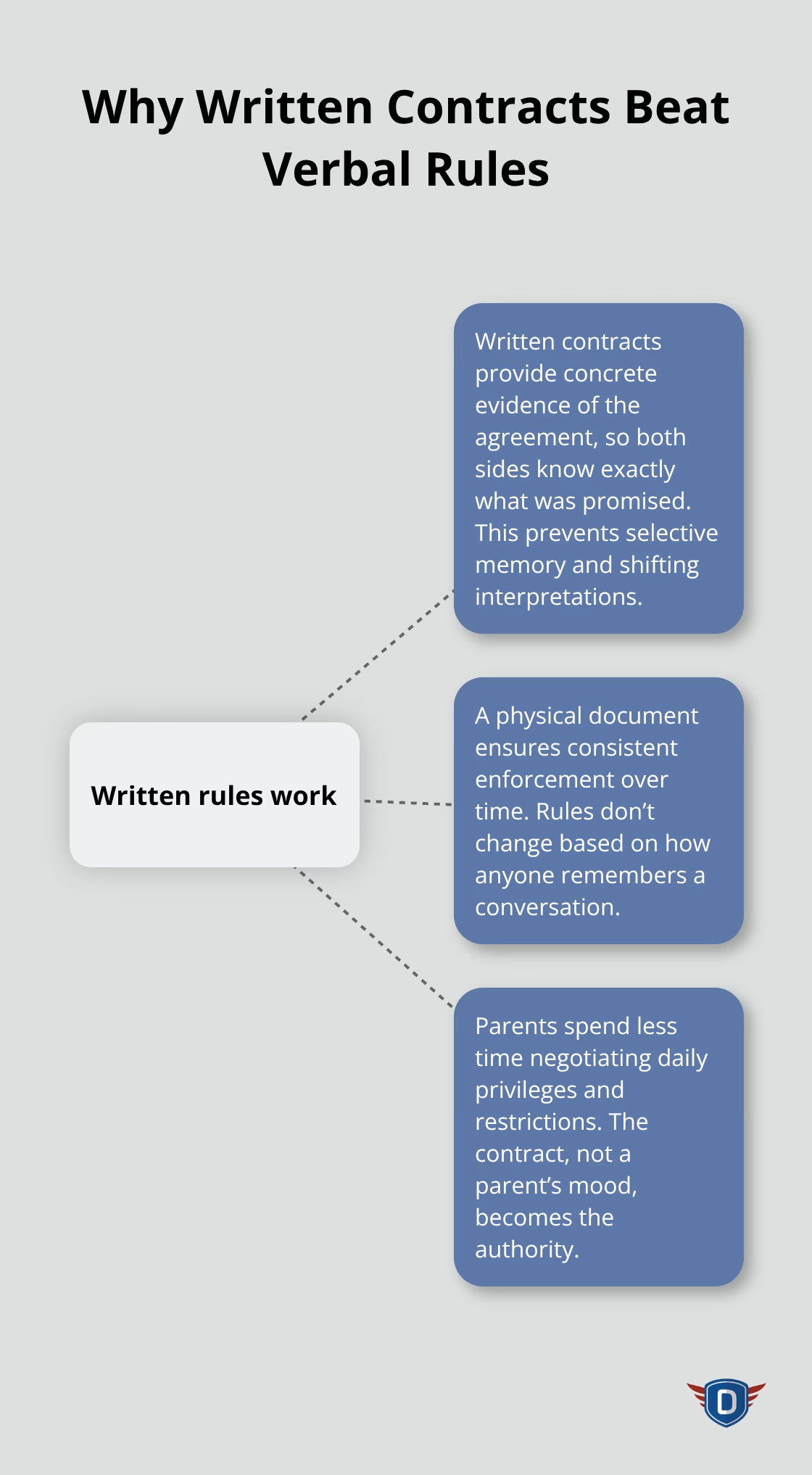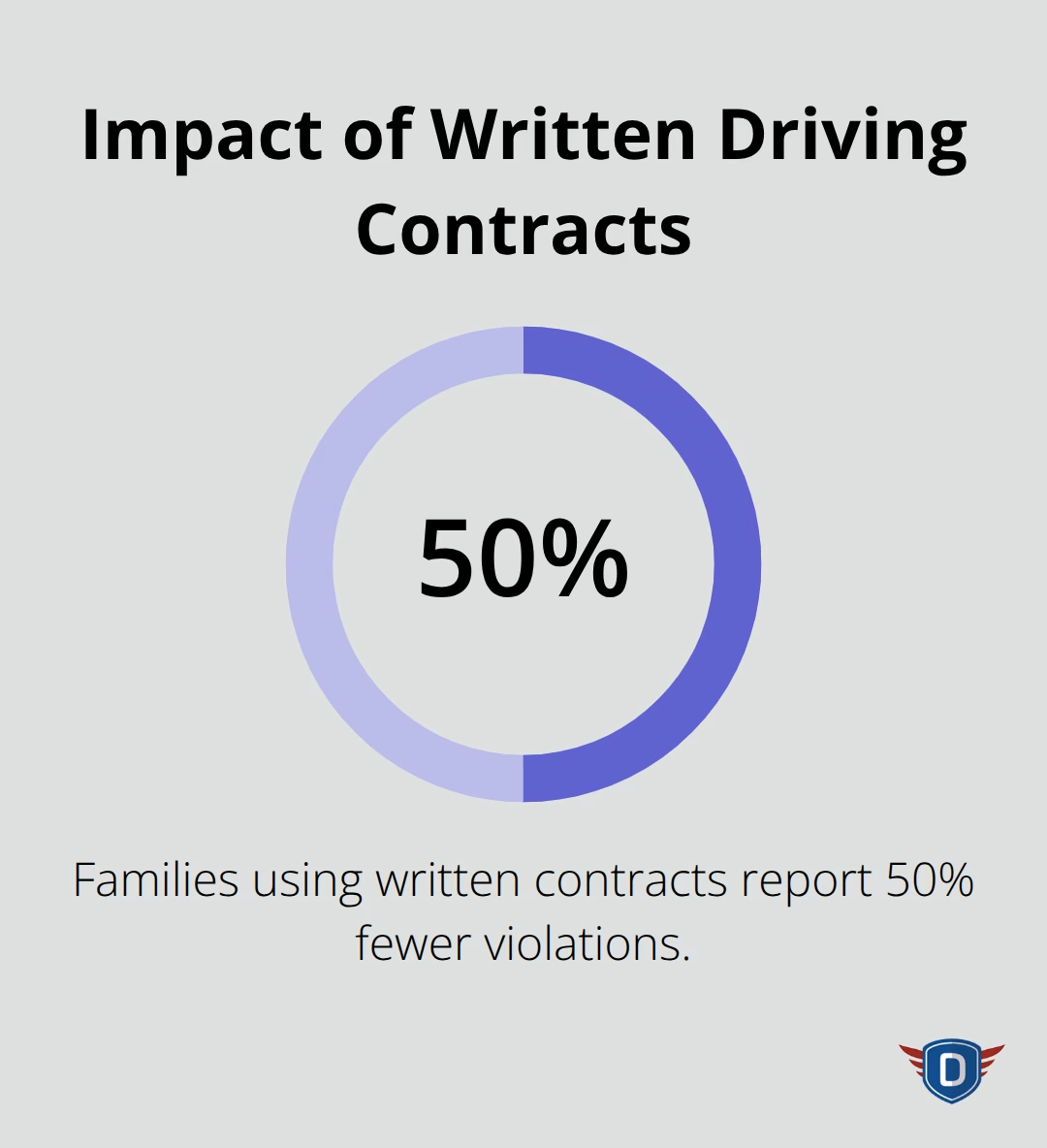Teen drivers face crash rates three times higher than experienced drivers, making clear boundaries essential for family safety.
A parent-teen driving contract transforms vague expectations into specific, enforceable agreements that both parties understand and commit to following.
We at floridadetscourse.com have seen how written contracts reduce driving violations by up to 50% compared to verbal rules alone.
What Makes a Parent-Teen Driving Contract Work
The Foundation of Family Driving Safety
A parent-teen driving contract is a written agreement that specifies driving rules, consequences, and privileges between parents and their teenage driver. Written contracts create accountability through clear documentation, unlike verbal discussions that teens often forget or misinterpret. The National Highway Traffic Safety Administration provides comprehensive information on teen driving safety issues and offers valuable resources for families establishing driving agreements.
The contract serves as a reference point during disputes and eliminates the he-said-she-said arguments that plague many families. Research from the Insurance Institute for Highway Safety shows that teens with formal agreements demonstrate better compliance with safety rules and fewer risky behaviors behind the wheel.
Legal Documents vs Family Agreements
Parent-teen contracts differ significantly from legal documents in their enforcement and consequences. These family agreements carry no legal weight in court, but they create powerful social contracts within the household. The consequences focus on privilege removal rather than legal penalties-teens lose car access, face earlier curfews, or complete additional supervised hours.
Legal violations like tickets or accidents still result in official consequences through the court system and insurance companies. The family contract addresses day-to-day behaviors that laws cannot regulate effectively (passenger limits, destination restrictions, or communication requirements). Research indicates that teens benefit from written agreements because they provide clarity about driving expectations and requirements.
Why Written Rules Outperform Verbal Agreements
Written contracts provide concrete evidence of what both parties agreed to follow. Verbal rules often change over time as parents and teens remember different versions of conversations. The physical document prevents selective memory and creates consistency in rule enforcement.
Research shows that teens respond better to written expectations because they can review the rules independently. Parents also benefit from written contracts because they reduce daily negotiations about privileges and restrictions. The contract becomes the authority, not the parent’s mood or memory on any given day.

These documented agreements set the stage for the specific elements that make contracts truly effective in practice.
Essential Elements of an Effective Driving Contract
Setting Non-Negotiable Boundaries
Your contract must specify exact passenger limits, curfew times, and geographic boundaries rather than vague suggestions. Teen drivers face significant crash risks, with young drivers accounting for 8.1% of fatal crashes despite being only 5% of licensed drivers. Set specific times like no driving after 9 PM rather than no late-night driving, and define exact consequences like loss of car privileges for one week after the first violation.
The contract should mandate seat belt use for all passengers, prohibit phone use while driving, and require teens to text their location every hour during longer trips. Include weather restrictions that prevent driving during rain, snow, or fog until teens complete 50 supervised hours in various conditions. Academic requirements work effectively too – many families require teens to maintain a B average to keep driving privileges (studies show this improves both grades and driving behavior).

Consequences That Actually Work
Effective contracts use graduated penalties that increase with repeated violations rather than identical punishments for every offense. First-time speeding violations might result in two weeks of supervised driving only, while second offenses trigger one month without any driving privileges. Teens who face consistent, escalating consequences show better rule compliance than those with inconsistent enforcement.
Document specific violations and their corresponding penalties in writing – texting while driving results in immediate phone confiscation plus loss of driving privileges for 30 days. Include positive consequences too, like extended curfews or additional passengers after teens complete six months without violations. Parents who track violations and rewards through written logs see significantly better teen cooperation and fewer arguments about fairness during enforcement.
Graduated Privileges That Build Trust
Smart contracts start with restrictive rules and gradually expand privileges as teens demonstrate responsibility. Begin with daytime driving only to school and work locations, then add evening hours after three months of violation-free driving. The graduated approach mirrors state licensing systems but allows families to set stricter standards than legal minimums require.
Monthly privilege reviews create opportunities to discuss driving experiences and adjust rules based on demonstrated skills. Teens who earn expanded privileges through good behavior show stronger commitment to safety rules than those who receive immediate full access. This systematic approach to privilege expansion prepares teens for the responsibility discussions that shape your contract development process.
How Do You Build Your Family Driving Contract
Start With Data Collection and Family Input
Begin your contract development by gathering specific information about your teen’s driving needs and your family’s non-negotiables. Document your teen’s school schedule, work hours, and regular activities to establish realistic boundaries rather than arbitrary restrictions. Parent involvement in the early driving process improves outcomes when families collaborate on rule-setting rather than impose rules unilaterally.
Schedule a family meeting where everyone contributes ideas about privileges, restrictions, and consequences. This collaborative approach creates buy-in from your teen while you maintain parental authority over final decisions. Create a written draft that includes specific times, locations, and passenger limits based on your discussions.
Establish Clear Standards and Consequences
Include your state’s graduated licensing requirements as minimum standards, then add stricter family rules where appropriate. Document consequences that escalate with repeat violations – first offense results in supervised driving for two weeks, second offense removes privileges for one month, and third offense requires retaking driver education.
Parents who use this systematic approach report fewer arguments and clearer expectations than families who create rules spontaneously during conflicts. Write down specific violations and their corresponding penalties to eliminate confusion later (texting while driving equals immediate phone confiscation plus 30-day privilege loss).
Present the Contract as a Partnership
Present the contract as a partnership agreement rather than a list of punishments during your discussion with your teen. Start the conversation by acknowledging that driving represents freedom and responsibility, then explain how the contract protects both your teen’s safety and your family’s peace of mind.
Improving communication between parents and teens about driving practices leads to better outcomes when teens understand the reasoning behind rules rather than simply receiving orders without explanation. Review each section together and allow your teen to ask questions or suggest modifications to unreasonable restrictions.
Formalize the Agreement
Sign the document together to demonstrate mutual commitment – this ceremony reinforces the agreement’s importance and creates accountability for both parties. Schedule monthly review meetings to discuss driving experiences, address challenges, and potentially expand privileges based on demonstrated responsibility.
Families who maintain regular contract discussions see sustained improvements in teen driving behavior over time. Keep the signed contract visible (on the refrigerator or family bulletin board) as a constant reminder of the agreed-upon rules and expectations.
Final Thoughts
Parent-teen driving contracts deliver measurable safety improvements that extend far beyond the initial learning period. Families who use written agreements report 50% fewer violations and significantly reduced stress during the teen years. These contracts create accountability structures that teens carry into adulthood and form the foundation for lifelong safe driving habits.

The long-term impact reaches beyond individual families. Communities with higher parent-teen driving contract adoption rates show lower teen crash statistics and reduced insurance claims. Teens who follow structured agreements develop better risk assessment skills and demonstrate more responsible decision-making in challenging situations (particularly during nighttime or adverse weather conditions).
Professional guidance makes the process easier for families who want to maximize their contract’s effectiveness. We at floridadetscourse.com help families navigate teen driver education through our comprehensive programs that complement your parent-teen driving contract. Start your driver education journey today to build the foundation for your teen’s safe future on the road.







